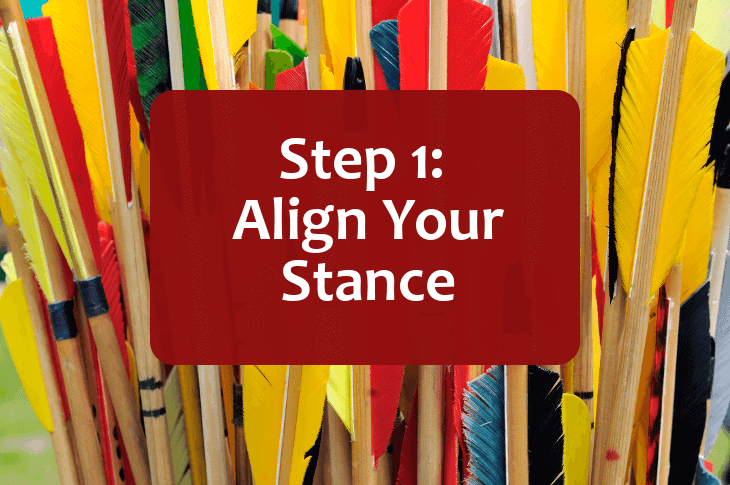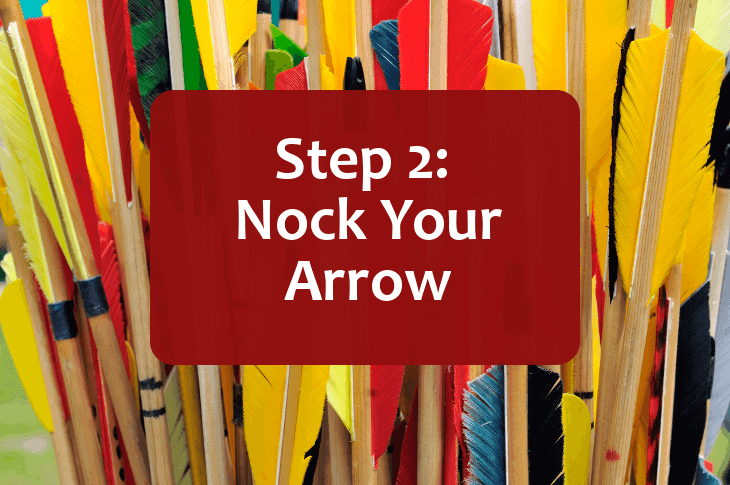In the last step (Step #9), we discussed the follow-through motion your body should have after you release the arrow: your string hand should fall back a little, your chest should open a little bit, and your back muscles should contract a little bit. The top of the bow may come forward a little bit, especially if you’ve got a nice, calm grip on the bow.
In this step—Step #10—we’ll review the shot sequence, and think about what you got right and what you got wrong.

What to Review
This step—“Reflect”—is perhaps the most important task in all of the steps we’ve talked about. You can practice more than anyone in the world, but if you’re not paying attention what works and what doesn’t, you’re not going to improve. So after each end, take a second, and go through each part of your shot. Ask yourself:
- How was your stance? Were you feet parallel to the shooting line? Were your knees slightly bent, was your torso facing the same way as your feet, and was your head facing the target? Did your body drift at all during the shot? Were your muscles relaxed? (Step 1)
- Did you nock your arrow correctly? When you were standing on the line, did you have your bow pointing towards the ground before the shot with the limbs vertical, and did you make sure you had the index vane pointing the right way? (Step 2)
- Did you you grasp the bow string correctly? If you’re using a recurve, did you hold the bow string in the valley of your first knuckle joints? If you’re a beginner, did you utilize the Mediterranean draw correctly? (Step 3)
- Was your grip on the bow relaxed? Or did you strange it too much, so that it shook upon your release? (Step 4)
- How was your form when you raised your bow arm? Were your shoulders low, or were they scrunched up? Were you muscles relaxed? Was your elbow at a 9-and-3 position, or was it pointing in all sorts of weird directions? Was your elbow hyper-extended? (If it was, you may be in extreme pain after your shot!) Did you keep your bow below the target when you raised your bow arm? (Step 5)
- How clean was your draw? Was your head held up straight? How was your stance? Was your drawing arm flat, with your wrist flat as well? Did the draw feel too heavy or too light? Was your bow arm shaking, or did you find your bow drifting upward as you drew? (Those might be signs you’re using too heavy a bow). Were you able to maintain your grip on the bow string? (Step 6).
- Did you properly connect to your anchor point? Did you bring your string hand to your anchor point, or did you draw and then bring your anchor point to your hand? Did you keep your mouth closed, so as not to alter your anchor point? (Step 7)
- How was your aim? Were you accurate? Did your arrows group well? Do you need to “chase the arrows,” and adjust your bow sight? (Step 8).
- How was your release? Did you gracefully allow your string hand to release the bow string? Did you feel your chest expand as you let the arrow loose, and did you feel your back contract a little? Did you move your bow arm during or after the release? (Step 9)
- Did you review your shot? Did you ask yourself all these questions, and did you try and figure out what went right, and what went wrong? (Step 10)
Finally–how did it feel?? Did your body feel natural? Odd? How did that feeling translate into your shot?
It’s a long checklist, but the longer you’re archer, the more quickly you’ll run through it–and the fewer problems you’ll have. Remember, this is a sport that rewards repetition, so find out what you’re doing right, find out what you’re doing wrong, and make adjustments until you’re highly skilled.
One Extra Step That’s Important
Here’s one other bit of advice, that might be the most valuable bit of advice in this entire “How to Shoot a Bow and Arrow” series of posts: after you shoot and after you review your shot, write down your findings, immediately.
You may not have insights after every end you shoot, and that’s totally OK—but when you discover something (like, “The looser I make my bow hand, the better my arrows group” or “I always shoot poorly with a new finger tab” or whatever) write it down immediately. Keep a notepad in your quiver or enter your thoughts into your iPhone. If you wait until later, you’ll forget what you’ve learned.
This is, far and away, the step that most archers wish they could skip. It can be a drag to stop and record your thoughts, and it may look a little bit nerdy to take notes all the time, but I promise you: it works. If you want to get better and improve your skills, take notes. (And, if I’m being honest—I love this part of the routine! If I make a great shot, it allows me to re-live what I did, and it enjoy it longer).
After You’ve Shot an End…
After each shot, review what you’ve done right and what you’ve done wrong.
After you’ve shot a full end—an “end” is usually a group of six arrows—see if you’ve got a grouping, or adjust your scope if you need to.
Then…
Keep practicing! As you develop skill and experience, you’ll form a deep understanding of the shot sequence, and how to make it work so that you’re accurately hitting your target, again and again.
If you truly want to develop your skills, find a coach, and then come back to us when you’ve made it to the Olympics!




